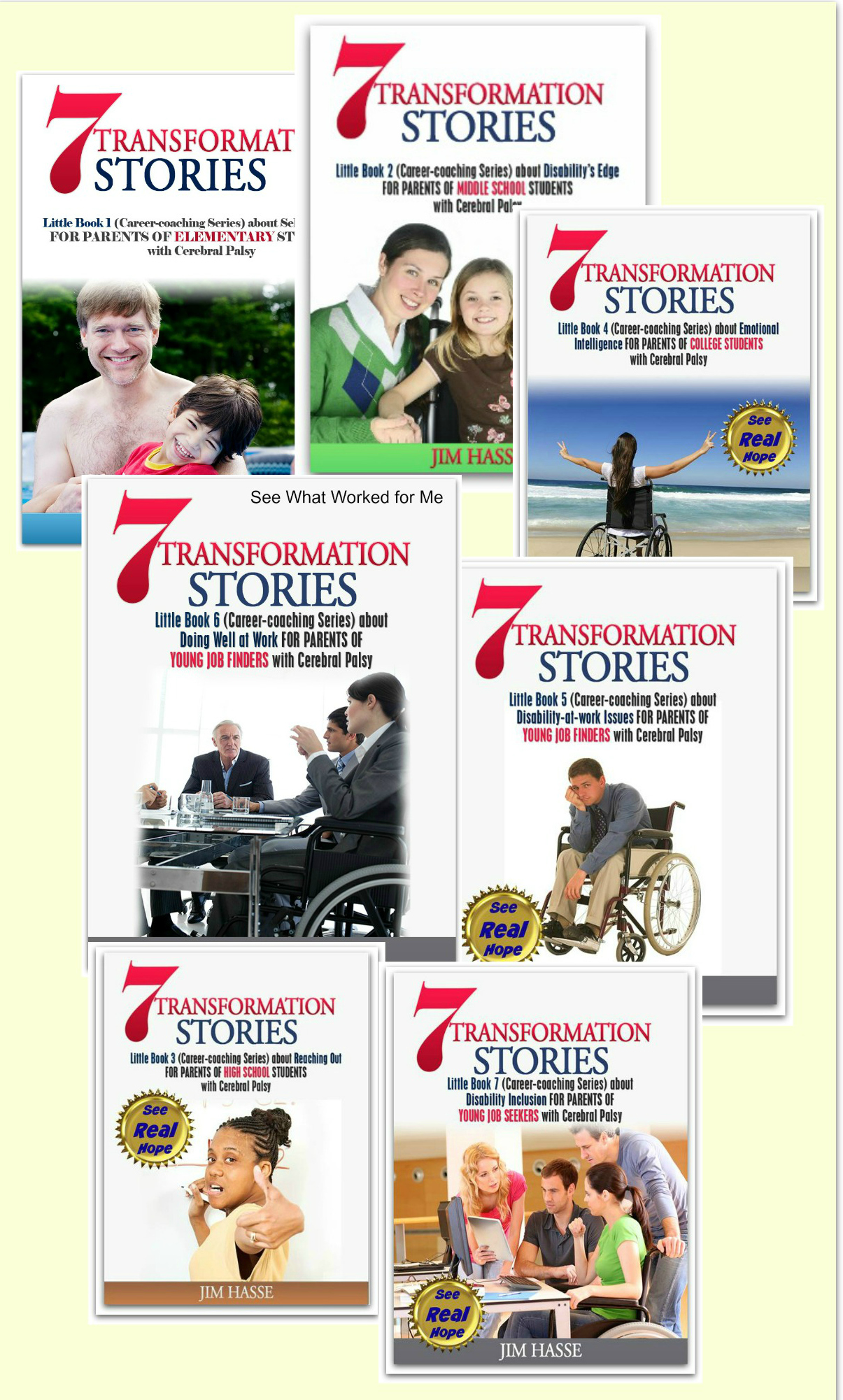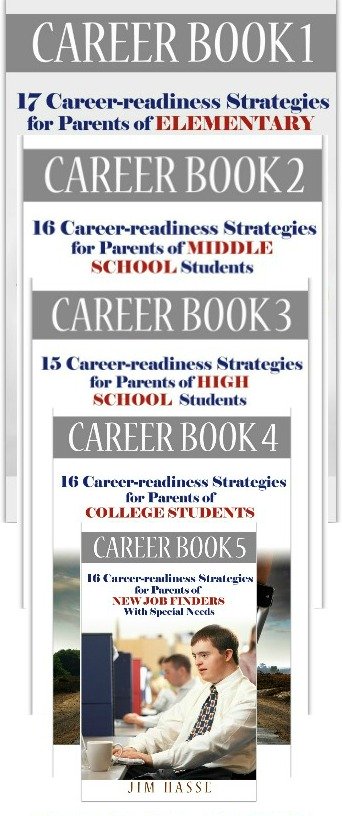Career Information for High School:
A Cerebral
Palsy Career Builder
By Jim Hasse, ABC, GCDF, Disability Employment Expert
_________________________________________________________
Career information for high school students needs to address a basic question, one your youngster is probably asking him or herself: “Where do I want to work?”
High school may seem a bit early for addressing that question, but it’s not really premature, especially for your youngster with cerebral palsy (CP). Your high school student needs to move beyond “fantasy careers” he or she may have envisioned at seven. At 17, the right career information for high school students just may be the jolt your youngster needs to start dealing with reality.
Here’s a true story you may want to pass on to your son or daughter.
John’s story
John recently received his Ph.D. in plastics and
polymers research from a major Midwestern state university and, for the first
time, found himself seeking a job outside of a campus setting.
He had interviews with several blue chip companies on
the East Coast as well as the Midwest but didn’t find the type of corporate
culture he was seeking.
After a couple of months of considering his
alternatives (all basic career information readily available for high school students), he joined a Twin Cities start-up firm, which has been in business
for four years and is currently employing nine full-time people. He has a
one-year research and development fellowship with the startup at a reasonable
stipend with the possibility of a full-time job after that.
He didn’t realize how well he was going to fit into
the small firm’s culture until he started working. After a few weeks, he
realized he thoroughly enjoyed working with his team.
John also didn’t realize the sizable potential the
firm had until he signed the company’s confidential agreement and started work.
He’s excited about the startup’s potential.
While making the transition from school to work, John
rather quickly sifted through career information available for high school
students but often not considered by youngsters still in school until it’s
“crunch time” and the job market is suddenly upon them.

Workplace options
Your youngster can get the jump on job seekers such as John by shifting through the following career information for high school students and taking time to think about “Where do I want to work?”
There are basically seven answers to that question. When the time comes, your son or daughter can seek a job in a startup company; a small, well-established business; a large national and multi-national business; a non-profit/non-governmental organization; a local/state governmental agency; or in Federal government service. Or he or she can pursue self-employment.
That's basic career information for high school students.
There are advantages and disadvantages for each of these seven different types of workplaces -- ranging from job growth potential to everyday work flexibility.
Which workplace situation will be best for your youngster a decade from now? It depends on personal preferences when it comes to risk tolerance, on-the-job autonomy, career path development etc. but, now’s the time to start discussing the available career information for high school students which can make a difference between a frustrating first job out of school and one that is satisfying and motivating.
Let’s take a closer look at John’s choice, a startup company, in terms of these five factors:
- Job growth
- Acceptance
- Accommodations
- Authority
- Compensation
Some of these factors have implications for your future job seeker as he or she deals with CP and the barriers it can put up in finding employment and doing well in a workplace.
Job Growth
In July, 2010, the Ewing Marion Kauffman Foundation
released a study which shows net job growth occurs in the U.S. economy mainly through
startup firms.
The study, “The Importance of Startups in Job Creation and Job Destruction,” bases its findings on the Business Dynamics Statistics (BDS), a U.S. government dataset compiled by the U.S. Census Bureau.
The BDS series tracked the annual number of new businesses (startups and new locations) from 1977 to 2005. It defines “startups” as firms younger than one year old.
The BDS data shows that, both on average and for all but seven years between
1977 and 2005, existing firms are net job destroyers, losing one million jobs
net (combined) per year. By contrast, in their first year of operation, new
firms add an average of three million jobs.
Most notably, during recessionary years, job creation at startups remains stable, while net job losses at existing firms are highly sensitive to the business cycle.
On average, one-year-old firms create nearly one
million jobs, while ten-year-old firms generate 300,000. The notion that firms
bulk up as they age is, in the aggregate, not supported by data.
Citing the Kauffman study, John Tornius, chairman of
Serigraph, a printing, molding, and custom graphics company in Milwaukee, WI,
urges states and universities to “hug entrepreneurs” to help a region thrive by
providing them with “angel capital” and start-up business expertise to keep
them in the area. “They may eventually become a Microsoft, a Google or a
Facebook, all startups started by college students,” he notes.
“We’re an innovation economy,” he explains, pointing
to the partnerships formed by universities and local entrepreneurs for the
economic growth in such areas as Boston, New York City, Minneapolis, Austin,
the Research Triangle, Seattle, Silicon Valley etc.
Tornius’ bottom-line recommendation: Avoid “old industry” states. Search for startups in states which have highly paid young people; people in the “creative class;” high quality of life (recreation, arts etc.); and accessibility features that are essential for people with a variety of disabilities, he urges. Go to where the startup jobs are and where local, non-governmental groups are providing startups with support and money.
Those are bits of career information for high school students I wish I had in 1960.
Acceptance
There’s another reason your future job seeker may
want to look for work in geographical areas which attract startup companies and
the younger people who work for them. They may find more hiring managers who
are not hampered by false assumptions about disability.
For instance, Generation Y (born between 1977 and 1995) hiring managers (both men and women) within small companies (particularly within the high-tech sectors) are generally more tolerant of diversity than previous generations.
They are simply seeking individuals who can help them
gain an edge over their competitors and colleagues, according to Jason Ryan
Dorsey, author of “Y-size Your Business: How Gen Y
Employees Can Save You Money and Grow Your Business.”
Your youngster will need to capitalize on that opportunity of stepping beyond old stereotypes -- a valuable bit of career information for high school students.
Accommodations
Small employers (particularly startups) often operate on extremely tight budgets and may not be held as accountable to ADA mandates as larger companies. So, here your youngster will have an opportunity to show his or her creativity, teamwork and problem-solving ability.
How about sharing the cost of any adaptive software your future job seeker might need with a prospective employer? Now’s the time to research and keep abreast of new technologies which can make that possible. Make that a part of the career information for high school students (a good title for an e-mail file) you and your youngster collect.
At any rate, your youngster needs to be prepared to draw upon personal experience in offering potential solutions to any workplace accommodation he or she may need down the road during a school-to-work transition.
Authority
Unlike
a federal or state job or a position in large company, a job in a startup may
not be tightly defined. Your youngster could be more of a generalist, and individual
authority may be unclear.
That means your son or daughter will need to thrive
in a little bit of ambiguity, have a willingness to be flexible, be able to
carry out a variety of functions (even though he or she has CP) and live under
a set of sometimes sizable but calculated risks.
In
return, there’s probably an opportunity for an industrious individual such as
your youngster to create a slot for his or herself with a startup and take an
important step in building a career.
But, the shining potential of a startup should never
hide reality. Your youngster will need to carefully analyze each potential
startup’s capitalization, business plan, core offering, competitors, and
corporate culture. Most importantly, he or she will need to assess the business
acumen, the creativity, and the values of the principal players.
Notice the attributes your youngster needs in order to thrive in a startup: clear personal values, business acumen, good judgment etc. Now’s the time to use this career information for high school students and start developing those attributes.
Compensation
If your youngster eventually joins a startup company, he or she may receive a salary but more likely, at the beginning, be offered compensation of the more creative variety -- from stock options, deferred pay, stipends or even volunteer work (to show what he or she can contribute to the team effort).
You
may want to remind your high school student that volunteering or working at a
part-time job for a startup during college may be one way to “get a foot in the
door” of a budding enterprise.
In short, startups need workers who are innovative and resilient and who can deal with ambiguity and risk -- attributes your youngster may be acquiring now while learning how to live well CP.
Such career information for high school students can be crucial to your youngster's career development. If he or she is that type of person, a startup company may be the right step to take in making the school-to-work transition.
Return from Career Information for High School to Part-time Jobs
Go to Cerebral Palsy Career Builders
This is Creative Commons content. You can freely and legally use, share and repurpose it for non-commercial purposes only, provided you attach this sentence and the following attribution to it (including the two links):
Originally written and illustrated by Jim Hasse, ABC, GCDF, owner of Hasse Communication Counseling, LLC, who, as a person with cerebral palsy, served for 10 years as a vice president in a Fortune 500 company during his 29-year career in corporate communication. He’s an Accredited Business Communicator, certified as a Global Career Development Facilitator and author of 14 Amazon books about disability awareness and disability employment issues.





